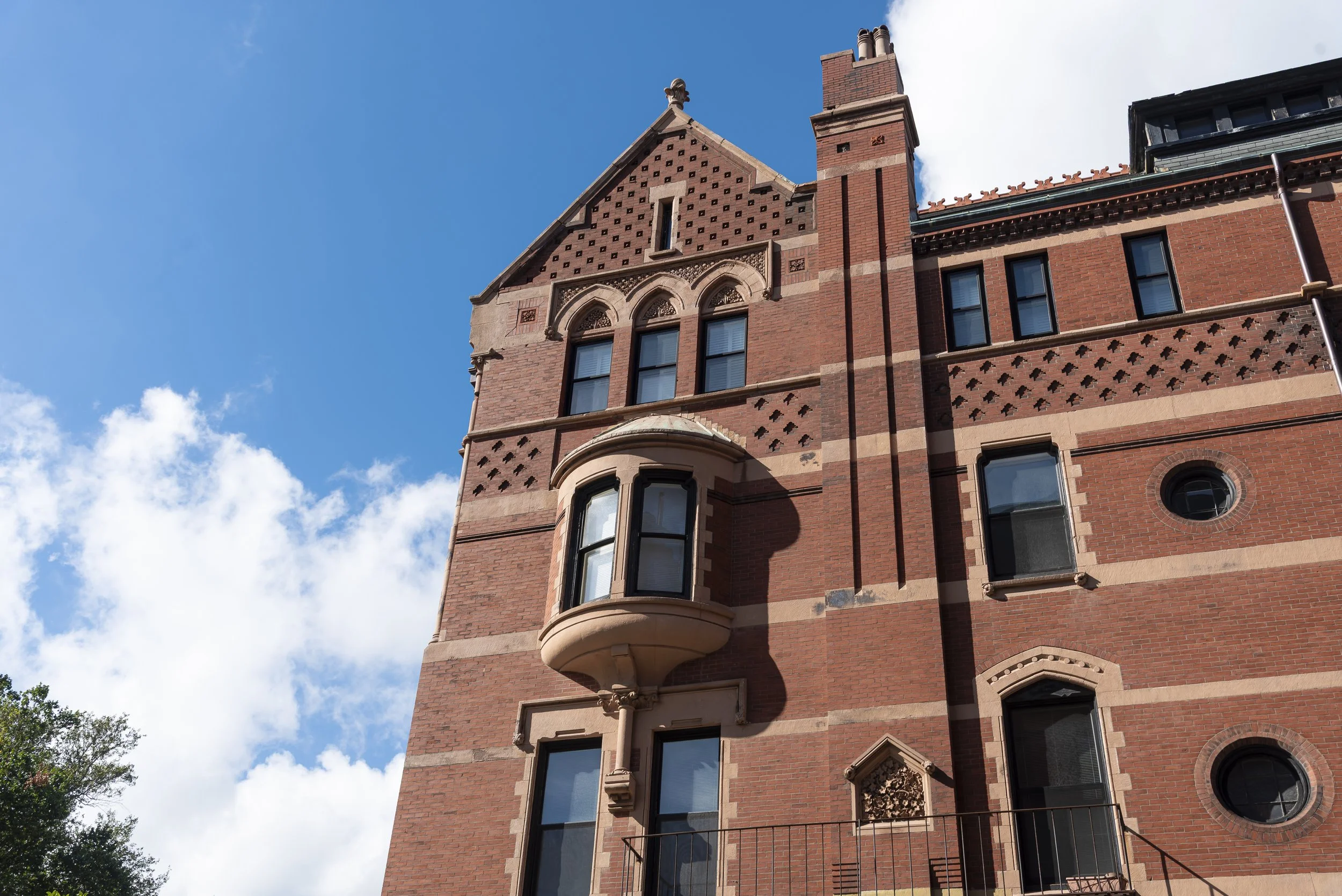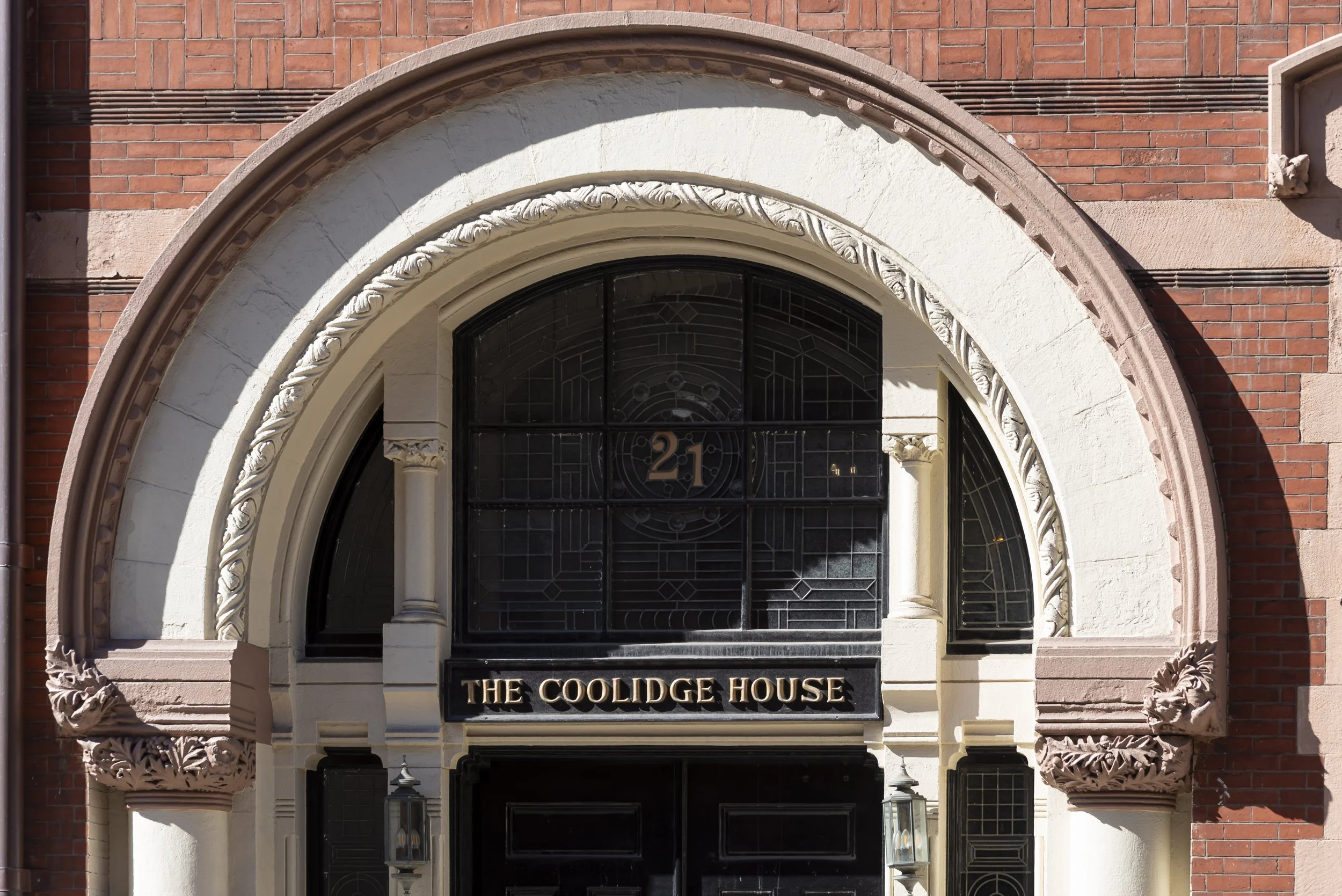The Coolidge House
72 Fairfield Street, Back Bay, Boston
21 Fairfield Street has been part of Boston’s Back Bay story for nearly a century and a half. Situated at the northwest corner of Fairfield Street and Commonwealth Avenue, its presence is elegant yet commanding, deeply tied to the architectural, cultural, and social evolution of one of the city’s most celebrated neighborhoods. Like much of Back Bay, it reflects a history of ambition, transformation, and enduring prestige.
The building began with the vision of George Parsons King, a successful iron and steel manufacturer and prominent Boston businessman. In 1880, King purchased a lot at the corner of Fairfield and Commonwealth from the estate of William Powell Mason and commissioned architect William Whitney Lewis to design an imposing private residence. Construction began later that year, carried out by the firms Standish & Woodbury and John Morrison, and the house was completed in 1882 (Boston Globe, 1882). During construction, the King family resided at the nearby Hotel Vendôme, a popular choice among Boston’s elite (Building of New England, 1882).
The result was a four-story townhouse built in the high Victorian style, faced with red brick and brownstone and featuring an octagonal bay that anchored the corner lot. The arched entrance on Fairfield Street opened into a series of formal reception rooms with tall ceilings, carved woodwork, marble fireplaces, and sweeping staircases designed to impress both family and guests (Boston Globe, 1882). A detailed account of the residence’s interior published shortly after its completion described spacious parlors, a formal dining room, and a library — all oriented to maximize light from the building’s multiple exposures (Boston Globe, 1882).
Throughout the late nineteenth century, 21 Fairfield was home to many of Boston’s most prominent families. During the winter of 1884–85, it was leased to Charles Francis Adams Jr., a railroad executive and grandson of President John Quincy Adams, and his wife Mary Ogden Adams (Boston Globe, 1885). The Kings returned soon after and remained until George King’s death in 1895. Over the next several years, the property was occupied by Louis and Amy Cabot, members of one of Boston’s wealthiest merchant families, and later by Edwin Carlton Swift, a partner in the Swift meatpacking company, who briefly purchased the home before selling it to new owners (Boston Globe, 1895).
In 1896, the residence was acquired by Albert and Mary Bigelow, who lived there with their three sons during the height of the Gilded Age (Boston Globe, 1896). The property changed hands again in 1903, purchased by philanthropist George Robert White, who announced plans for major renovations before selling it to Ellen Wheaton Wood, wife of William Madison Wood, president of the American Woolen Company (Boston Globe, 1903). Under the Woods, the house became a center of social life in Back Bay, hosting gatherings that reflected the family’s influence and wealth. The Woods lived at 21 Fairfield for over three decades, raising their children there and preserving the home’s architectural integrity (Boston Herald, 1905). During this time, William Wood faced public scrutiny during the 1912 Lawrence textile strike but was acquitted of wrongdoing the following year (Boston Globe, 1913).
Following William Wood’s death, the home was sold in 1929 to Frank Waterman Stearns, a prominent businessman and close adviser to President Calvin Coolidge, and his wife Emily Williston Stearns (Boston Globe, 1929). The Stearns family lived at the property until Frank’s death in 1939 and Emily’s in 1940. Later that year, Germaine Alice Hubbard acquired the home and converted it into a lodging establishment known as The Duchess House, a reflection of the broader post-Depression shift as many large Back Bay homes were adapted for multi-tenant use (Boston Herald, 1940).
The mid-twentieth century saw further transformations as 21 Fairfield continued as a boarding house under successive owners. John E. Harrington purchased the property in 1942, followed by Mabel Anne Doyle in 1943, and later Charles Management Corporation, which leased it to Emma Crossett to continue lodging operations (Boston Globe, 1943). During this period, the interior was reconfigured to accommodate multiple tenants, though many original features — including wood paneling, fireplaces, and staircases — remained intact (Boston Globe, 1950). In 1966, the property was acquired by Frank O’Connor Realty Company, which held it until the late 1970s (Boston Herald, 1966).
A new chapter began in 1979 when the trustees of the 21 Fairfield Street Trust purchased the property and received approval to convert it into six luxury condominium residences (Boston Globe, 1979). Completed later that year, the conversion retained the building’s original character while introducing modern amenities. The newly named 21 Fairfield Street Condominium became a model for adaptive reuse in the Back Bay, preserving its historic façade and many interior details while providing updated kitchens, baths, and layouts (Boston Globe, 1980).
Today, 21 Fairfield, known as The Coolidge House, remains one of the most desirable addresses in the Back Bay. The building contains six distinct condominium units, each designed to highlight the structure’s architectural character. Period features such as original fireplaces, intricate wood moldings, and high ceilings are complemented by modern upgrades, including chef’s kitchens, spa-like bathrooms, and direct elevator access. Some units feature private rooftop terraces with sweeping views of the Commonwealth Avenue Mall and Back Bay skyline, while others offer oversized windows and multiple exposures that flood interiors with natural light. Recent sales include Unit 6, which sold for $1,630,000 in 2021, $255k above asking price, and Unit 4, a floor-through residence known for its five fireplaces and spacious layout.
The building’s location adds to its appeal. Situated directly on the Commonwealth Avenue Mall, 21 Fairfield is steps away from Newbury Street’s boutiques, the Charles River Esplanade, Fenway Park, and cultural landmarks such as Symphony Hall and the Boston Public Library. Universities including Boston University and Berklee College of Music are nearby, infusing the area with energy and vibrancy (Boston Globe, 2022).
What makes 21 Fairfield remarkable is not only its architecture but its remarkable adaptability. From George King’s original vision of a grand Victorian townhouse to William Wood’s Gilded Age residence, from a mid-century lodging house to an exclusive condominium, the property has mirrored the evolution of Back Bay itself. For buyers, it offers the rare chance to own a piece of Boston’s living history while enjoying modern comforts. For sellers, it represents not just a home but a legacy — a testament to the city’s enduring architectural heritage and timeless appeal.
Contact: MatthewArmstrong@MRGproperty.com






